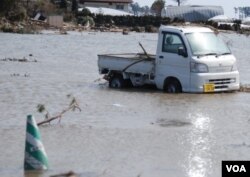The ability to accurately predict earthquakes is a holy grail of geology. Now, a group of researchers says it has found a previously unrecognized pattern just before larger earthquakes, observed with the devastating magnitude-9.0 tremor in northeastern Japan in 2011.
This “has the potential to help refine time-dependent earthquake forecasts,” according to an article published Friday in the journal Science.
“Although it will be a long way to make earthquake predictions that are useful for society, I believe this is a significant step toward that,” lead author Naoki Uchida, an assistant professor at Tohoku University’s Research Center for the Prediction of Earthquakes and Volcanic Eruptions, told VOA.
But several prominent scientists told VOA they had issues with the methodology and did not see this as a major breakthrough.
Slips prior to quake
Uchida, two Japanese colleagues and two University of California-Berkeley scientists have outlined data they said reveals that subtle slips began accelerating a few days before the massive quake on March 11, 2011, which unleashed a devastating tsunami.
The quake and resulting tsunami waves killed an estimated 18,000 people and triggered the meltdowns of three nuclear reactors in Fukushima, Japan.
The offshore quake was the largest ever known to hit the seismically active island nation.
Uchida and his colleagues analyzed the data of more than 6,000 seismic moments over a period of 28 years to detect slip-rate fluctuations in northeastern Japan.
“The results suggest the possibility of an earthquake is larger when slow slips are occurring,” Uchida told VOA. “By taking account of such relationships, the probability forecast of earthquakes can be improved.”
Slow (or aseismic) slips displace rocks much more slowly than earthquakes and without generating seismic waves. But these slow slips can increase stress in adjacent areas and may trigger damaging earthquakes.
The analysis done by Uchida and his colleagues revealed that intervals of slow slips range from one to six years — often coinciding with clusters of large magnitude earthquakes, according to the paper published Friday.
Some have doubts
There are doubts among others, however, that detecting these slow slips can lead to reliable quake forecasting.
“I think the best we could hope for from slow-slip events would be the same sort of modest probability gain,” said David Jackson, professor emeritus of Earth and space sciences at the University of California-Los Angeles.
Until scientists make testable predictions, however, “they have an interesting anecdote, not a fundamental discovery,” said Philip Stark, a professor of statistics at California-Berkeley who was not involved in the research.
Stark, speaking to VOA, also criticized the lack of “statistical care” in the Science paper, adding “the periodic slip model clearly does not fit the data well, but it's treated as ground truth.”
Looking backward
A prominent critic of quake prediction theories asserted that after big quakes it is easy to retrospectively say a particular movement was a foreshock.
“Despite 100 years of work, no one has ever found a way [going forward] to distinguish foreshocks from random small quakes,” said Robert Geller, a geophysics professor at Tokyo University. “So, unless you issue an alarm after every small quake, there's no way to use possible foreshocks to reliably predict big quakes.”
Hundreds or thousands of false alarms for every successful alarm is not something the public would tolerate, Geller told VOA.
Jackson at UCLA said he “agrees fully” with Stark and Geller.
“Readers will be drawn to the idea of earthquake prediction, but they will be much better informed if they are led to the logical constraints on the problem,” Jackson told VOA. “Meanwhile, let's wait for a track record of successful statements about future location, time and size limits for earthquakes after their predictions.”










